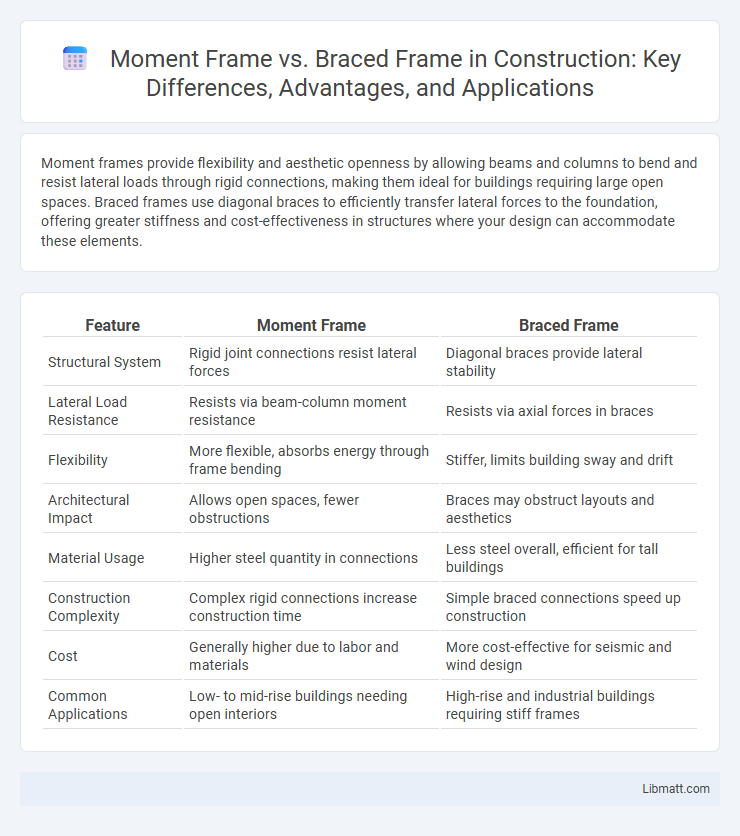Moment frames provide flexibility and aesthetic openness by allowing beams and columns to bend and resist lateral loads through rigid connections, making them ideal for buildings requiring large open spaces. Braced frames use diagonal braces to efficiently transfer lateral forces to the foundation, offering greater stiffness and cost-effectiveness in structures where your design can accommodate these elements.
Table of Comparison
| Feature | Moment Frame | Braced Frame |
|---|---|---|
| Structural System | Rigid joint connections resist lateral forces | Diagonal braces provide lateral stability |
| Lateral Load Resistance | Resists via beam-column moment resistance | Resists via axial forces in braces |
| Flexibility | More flexible, absorbs energy through frame bending | Stiffer, limits building sway and drift |
| Architectural Impact | Allows open spaces, fewer obstructions | Braces may obstruct layouts and aesthetics |
| Material Usage | Higher steel quantity in connections | Less steel overall, efficient for tall buildings |
| Construction Complexity | Complex rigid connections increase construction time | Simple braced connections speed up construction |
| Cost | Generally higher due to labor and materials | More cost-effective for seismic and wind design |
| Common Applications | Low- to mid-rise buildings needing open interiors | High-rise and industrial buildings requiring stiff frames |
Introduction to Structural Frames
Moment frames and braced frames are primary structural systems used to resist lateral forces in buildings, with moment frames relying on rigid beam-to-column connections and braced frames utilizing diagonal bracing for stability. Your choice between these systems affects building flexibility, construction cost, and architectural design, as moment frames allow more open spaces while braced frames offer greater stiffness. Understanding the differences in load distribution and seismic performance helps optimize structural integrity and safety in your construction projects.
What is a Moment Frame?
A moment frame is a structural system designed to resist lateral forces through rigid connections between beams and columns, allowing the building to flex without collapsing. It relies on the bending strength of beams and columns rather than diagonal bracing, providing architectural flexibility and open interior spaces. Understanding the differences between moment frames and braced frames helps you optimize your building's design for both strength and usability.
What is a Braced Frame?
A braced frame is a structural system designed to resist lateral forces through diagonal braces, typically made of steel or reinforced concrete, forming a rigid triangle with beams and columns. This frame enhances your building's stability by efficiently transferring lateral loads, such as wind or seismic forces, to the foundation. Unlike moment frames, braced frames provide greater stiffness and deformation control, making them ideal for high-rise buildings in seismic zones.
Key Differences between Moment and Braced Frames
Moment frames resist lateral loads through rigid connections between beams and columns, allowing buildings to flex and absorb energy during events like earthquakes. Braced frames use diagonal braces to create a stable triangulated system, providing high stiffness and efficient load transfer to the foundation. Moment frames offer architectural flexibility with open spaces, while braced frames prioritize structural rigidity and cost-effectiveness.
Structural Performance Comparison
Moment frames provide superior lateral resistance through rigid connections that allow beams and columns to bend without failing, offering excellent ductility and energy dissipation during seismic events. Braced frames rely on diagonal steel braces to resist lateral forces, delivering higher stiffness and reducing building sway but with less deformation capacity compared to moment frames. Your choice between the two depends on balancing flexibility, stiffness, and energy absorption needs for optimal structural performance.
Seismic Resistance: Moment Frame vs Braced Frame
Moment frames provide superior seismic resistance by allowing buildings to flex and absorb energy through rigid beam-to-column connections, reducing damage during earthquakes. Braced frames enhance lateral stability by using diagonal braces to transfer seismic forces directly to the foundation, offering high strength but less flexibility. Your choice between moment and braced frames depends on the desired balance of ductility and stiffness for optimal earthquake performance.
Cost Analysis and Construction Considerations
Moment frames generally incur higher construction costs than braced frames due to more complex connections and increased steel use required for rigidity. Braced frames offer cost efficiency with simpler, faster installation and less material intensive designs, making them favorable for budget-sensitive projects. Construction considerations include moment frames' flexibility in architectural design versus braced frames' superior lateral stiffness and ease of erection on-site.
Applications and Common Uses
Moment frames are commonly used in buildings requiring architectural flexibility and open interior spaces, such as office buildings and hospitals, due to their ability to resist lateral forces through beam-column connections. Braced frames are preferred in industrial facilities, warehouses, and structures with regular, repetitive layouts, offering efficient lateral stability and cost-effective construction. Your choice between moment and braced frames should consider the desired architectural design, building function, and lateral load requirements for optimal performance.
Advantages and Disadvantages of Each Frame Type
Moment frames offer superior architectural flexibility and enhanced resistance to lateral forces by utilizing rigid beam-to-column connections, making them ideal for open floor plans but tend to incur higher construction costs and increased complexity in design. Braced frames provide economical and efficient lateral load resistance through diagonal bracing, resulting in less material usage and faster construction times, though they can restrict architectural layouts and may introduce obstacles within interior spaces. Selecting between moment and braced frames depends on project priorities like cost efficiency, spatial requirements, and seismic performance.
Choosing the Right Frame System for Your Project
When choosing the right frame system for your project, consider that moment frames provide superior lateral resistance through rigid beam-to-column connections, ideal for buildings requiring open floor plans and architectural flexibility. Braced frames rely on diagonal braces to resist lateral forces, offering cost-effective solutions with higher stiffness and simpler construction for structures with regular layouts. Your selection should balance factors like architectural needs, seismic performance, budget constraints, and construction complexity.
Moment frame vs Braced frame Infographic

 libmatt.com
libmatt.com